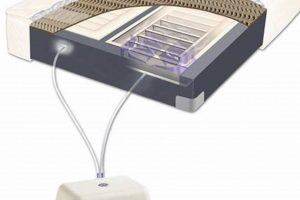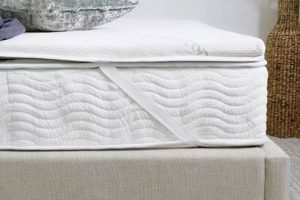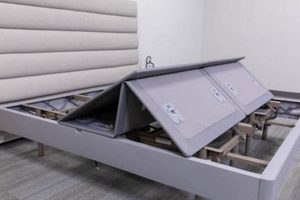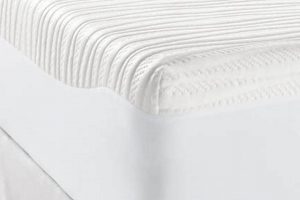A vital component of long-haul trucking, the sleeping surface within the cab’s designated rest area provides a space for drivers to recuperate during mandated off-duty periods. These mattresses are specifically designed to fit the often-compact and uniquely shaped sleeper compartments of commercial vehicles. Considerations in their construction include size, thickness, material composition, and support characteristics. Examples include innerspring, memory foam, and air-filled variants, each offering a distinct level of comfort and durability.
Driver well-being and safety are intrinsically linked to adequate rest. A comfortable and supportive sleeping arrangement directly contributes to improved sleep quality, mitigating fatigue and enhancing alertness on the road. This, in turn, reduces the risk of accidents and promotes overall road safety. Historically, these mattresses were often basic and utilitarian, but advancements in material science and ergonomic design have led to significant improvements in comfort and support, prioritizing driver health and performance.
The subsequent sections will delve into specific types of these sleeping solutions, exploring their respective advantages and disadvantages, factors influencing purchase decisions, and maintenance best practices. Information regarding relevant regulations and safety standards will also be presented to provide a comprehensive understanding of this essential element of the trucking industry.
Selecting and Maintaining Truck Sleeper Mattresses
Proper selection and maintenance of the sleeping surface in a commercial truck cab are critical for driver health and operational safety. The following tips offer guidance on optimizing the choice and care of these essential components.
Tip 1: Evaluate Mattress Type Based on Individual Needs: Consider options such as innerspring, memory foam, and air mattresses. Innerspring offers traditional support, memory foam conforms to the body’s contours, and air mattresses allow for adjustable firmness. Individual preferences and specific musculoskeletal needs should guide the decision.
Tip 2: Prioritize Proper Dimensions: Accurate measurements of the sleeper compartment are essential. A correctly sized mattress ensures optimal use of the available space and prevents discomfort caused by overcrowding or instability.
Tip 3: Assess Material Quality and Durability: High-density foam, reinforced stitching, and durable coverings contribute to the longevity of the mattress. Investing in quality materials minimizes the need for frequent replacements and ensures consistent support over time.
Tip 4: Implement Regular Cleaning Practices: Vacuuming the mattress regularly and spot-cleaning spills promptly prevents the build-up of dust mites, allergens, and odors. Maintaining a clean sleeping environment promotes better respiratory health and overall hygiene.
Tip 5: Utilize a Mattress Protector: A waterproof and breathable mattress protector shields the mattress from moisture, stains, and bed bugs. This simple addition significantly extends the lifespan of the mattress and simplifies cleaning.
Tip 6: Rotate and Flip Regularly: Rotating and flipping the mattress every few months promotes even wear and prevents sagging in specific areas. This practice helps maintain consistent support and comfort levels.
Adhering to these guidelines will contribute to a more comfortable and supportive sleeping environment within the truck cab, positively impacting driver health, safety, and operational efficiency.
The following section will provide information on warranty considerations and regulatory compliance relevant to these mattresses.
1. Dimensions
The dimensions of a truck sleeper mattress are of paramount importance, directly influencing both driver comfort and efficient utilization of the limited space within a commercial truck cab. Precise measurements are not merely a matter of convenience but are essential for ensuring a safe and restful sleep environment.
- Length and Width Accommodation
The length and width must correspond accurately to the dimensions of the sleeper berth. Undersized mattresses leave unusable gaps, while oversized mattresses may require forced compression, leading to premature wear and reduced comfort. Standardization is not universal; variations exist across different truck models and sleeper cab configurations. For example, a conventional long-haul truck sleeper might accommodate an 80-inch long mattress, whereas a smaller, regional-haul cab may only allow for a 75-inch length. Discrepancies can result in improper spinal alignment and compromised sleep quality.
- Thickness Considerations
Mattress thickness plays a crucial role in both comfort and vertical space utilization. Thicker mattresses, typically those exceeding 6 inches, often provide enhanced cushioning and support. However, excessively thick mattresses can reduce headroom within the sleeper, potentially causing discomfort or difficulty in maneuvering. Conversely, thinner mattresses, while conserving space, may lack adequate support, leading to pressure points and restless sleep. The optimal thickness represents a balance between comfort and ergonomic accommodation within the cab.
- Contouring and Edge Support
The contours of the mattress, particularly the edge support, contribute to the overall usable surface area. Mattresses with weak or collapsing edges reduce the effective sleeping area, especially for drivers who tend to sleep near the perimeter. Strong edge support ensures stability and prevents the feeling of rolling off the mattress, enhancing the sense of security and maximizing the available space. Some manufacturers incorporate reinforced edges specifically for this purpose.
- Impact on Sleeper Compartment Functionality
In addition to direct comfort considerations, mattress dimensions affect the overall functionality of the sleeper compartment. An ill-fitting mattress can impede access to storage compartments, interfere with seat adjustments, or obstruct the operation of safety equipment. A well-chosen mattress, properly sized to the available space, contributes to a more organized and functional living area, promoting both relaxation and operational efficiency.
The selection of a truck sleeper mattress with appropriate dimensions is a critical decision, impacting driver health, comfort, and the overall usability of the truck cab. Attention to these dimensional factors ensures a more restful and efficient working environment for long-haul drivers.
2. Materials
The composition of a truck sleeper mattress dictates a range of critical performance characteristics, impacting driver comfort, durability, and overall health. The choice of materials is not arbitrary; it represents a deliberate engineering decision balancing cost, support, longevity, and regulatory compliance. For example, polyurethane foam, a common core material, offers varying densities and firmness levels. Higher density foams generally provide superior support and resistance to compression over time, but also contribute to increased weight and cost. Conversely, lower density options may offer a more economical solution but are prone to quicker degradation and reduced support, potentially leading to discomfort and premature replacement.
The surface fabric, another critical material component, directly impacts breathability, moisture management, and resistance to wear and tear. Durable woven fabrics, such as polyester blends, offer enhanced resistance to abrasion and tearing, crucial in the demanding environment of a truck cab. Breathable fabrics, like cotton or specialized synthetic weaves, promote airflow, reducing moisture buildup and minimizing the risk of microbial growth. Consider the difference between a vinyl-covered mattress, selected for its ease of cleaning, and a mattress with a breathable, moisture-wicking cover; the former prioritizes sanitation, while the latter focuses on thermal regulation and comfort. Furthermore, the presence or absence of flame-retardant materials significantly affects compliance with federal safety standards.
Ultimately, the selection of materials for a truck sleeper mattress requires a holistic assessment of the intended use, the driver’s specific needs, and the prevailing regulatory landscape. A well-informed decision, guided by a thorough understanding of material properties and performance characteristics, translates directly into improved driver well-being, enhanced safety, and reduced operational costs. Challenges lie in balancing competing demands comfort versus cost, durability versus weight, and regulatory compliance versus material availability. Ongoing research and development continue to drive innovation in mattress materials, seeking to optimize these trade-offs and provide increasingly effective solutions for the trucking industry.
3. Support
The concept of support is fundamentally intertwined with the effectiveness of a truck sleeper mattress. It dictates the degree to which the mattress can properly align the driver’s spine, distribute weight evenly, and alleviate pressure points, all critical factors in achieving restorative sleep within the confines of a truck cab.
- Spinal Alignment
Maintaining proper spinal alignment is paramount for preventing back pain and promoting overall musculoskeletal health. A supportive mattress should conform to the natural curvature of the spine, preventing excessive sinking or arching. For instance, a mattress that is too soft can lead to spinal misalignment, resulting in lower back pain and stiffness. Conversely, a mattress that is too firm may create pressure points, particularly at the hips and shoulders. The ideal level of support ensures the spine maintains its natural alignment throughout the night, mitigating the risk of discomfort and injury.
- Weight Distribution
Effective weight distribution is essential for minimizing pressure points and promoting circulation. A supportive mattress will distribute the driver’s weight evenly across the surface, preventing localized areas of high pressure. For example, without adequate support, concentrated pressure on the hips and shoulders can restrict blood flow, leading to numbness, tingling, and discomfort. Mattresses incorporating zoned support systems, with varying levels of firmness in different areas, are designed to optimize weight distribution and alleviate pressure points.
- Edge Support and Stability
Edge support refers to the stability and firmness of the mattress perimeter. Strong edge support prevents the feeling of rolling off the mattress and maximizes the usable sleeping surface, especially crucial within the limited space of a truck sleeper. A mattress with weak edge support can compress under weight, reducing the effective sleeping area and creating a sense of instability. Reinforced edge support enhances overall stability and extends the lifespan of the mattress by preventing sagging.
- Material Density and Resilience
The density and resilience of the mattress materials directly impact the level of support provided over time. High-density materials, such as memory foam or high-density polyurethane foam, offer superior support and resistance to compression. These materials maintain their shape and firmness even after prolonged use, ensuring consistent support. Conversely, lower-density materials are prone to sagging and compression, reducing their ability to provide adequate support over time. The resilience of the materials determines their ability to recover their original shape after compression, contributing to long-term support and comfort.
The aforementioned facets of support underscore its inextricable link to the function and effectiveness of truck sleeper mattresses. A mattress that fails to provide adequate support can compromise driver health, reduce sleep quality, and negatively impact overall well-being. Therefore, careful consideration of these support-related factors is crucial when selecting a mattress for use in a commercial truck cab.
4. Durability
The durability of a truck sleeper mattress is a critical attribute directly impacting operational costs and driver well-being. The inherent conditions within a commercial truck cab constant vibration, temperature fluctuations, and prolonged use place significant stress on the mattress materials. A lack of durability results in premature degradation, requiring frequent replacements and leading to increased expenses. For example, a low-quality mattress subjected to daily use and temperature extremes may exhibit sagging, compression, and material breakdown within a short timeframe, necessitating replacement within a year or less. This, in turn, contributes to downtime and disrupts logistical schedules. Durability directly correlates with the mattress’s ability to withstand these stressors and maintain its supportive properties over an extended period. Therefore, the initial investment in a more durable mattress can prove more cost-effective in the long run by minimizing replacement frequency and associated expenses.
Material selection and construction techniques are primary determinants of mattress durability. High-density foams, reinforced stitching, and resilient coverings contribute to a mattress’s ability to withstand the rigors of the trucking environment. For instance, a mattress constructed with high-density memory foam and a durable woven cover will exhibit greater resistance to sagging and tearing compared to a mattress made with low-density foam and a thin, non-woven cover. Furthermore, factors such as resistance to moisture, mold, and mildew play a crucial role in maintaining the mattress’s integrity and preventing premature degradation. Consider the practical implications of a mattress developing mold growth due to inadequate ventilation; this not only compromises the driver’s health but also necessitates immediate replacement to avoid further contamination of the cab environment. Durability also extends to the mattress’s ability to retain its shape and support characteristics over time. A durable mattress will maintain its original firmness and contour, providing consistent support and comfort even after thousands of hours of use.
In summary, the durability of a truck sleeper mattress is a crucial determinant of its long-term value and operational efficiency. Choosing a durable mattress, constructed from high-quality materials and designed to withstand the demanding conditions of the trucking environment, translates to reduced replacement costs, improved driver comfort, and enhanced operational reliability. Overlooking durability in favor of short-term cost savings can lead to a cycle of frequent replacements and increased expenses. Prioritizing durability is an investment in the long-term health of both the driver and the business.
5. Regulations
The operational landscape of commercial trucking is governed by a complex framework of regulations designed to ensure driver safety, vehicle maintenance, and overall road security. The selection and maintenance of truck sleeper mattresses are not exempt from these regulations, albeit indirectly. While specific regulations directly mandating mattress composition or features are limited, several broader rules impact the usage and condition of these essential components.
- Hours of Service (HOS) Regulations
Federal Motor Carrier Safety Administration (FMCSA) Hours of Service regulations dictate the maximum driving time and mandatory rest periods for commercial drivers. These regulations necessitate the use of sleeper berths for extended rest periods, implicitly requiring a functional and safe sleeping surface. The absence of a suitable mattress could compromise a driver’s ability to obtain adequate rest, potentially leading to fatigue-related violations and safety risks. Enforcement officers may consider the condition of the sleeper berth, including the mattress, when assessing compliance with HOS rules. For instance, a driver logging required rest time in a cab lacking a usable mattress may face scrutiny regarding the validity of their rest period.
- Vehicle Maintenance and Inspection Regulations
Regulations pertaining to vehicle maintenance and inspections, such as those outlined in FMCSA’s Appendix G to Part 396 (Minimum Periodic Inspection Standards), indirectly influence mattress conditions. While not explicitly mentioning mattresses, these regulations mandate that all vehicle components be maintained in safe and operating condition. A severely damaged, unsanitary, or infested mattress could be construed as a maintenance issue, potentially leading to inspection failures or citations. For example, a mattress harboring mold or pests could be deemed a health hazard, prompting corrective action by enforcement personnel. The onus is on the carrier and driver to ensure the sleeper berth, including the mattress, meets acceptable standards of cleanliness and functionality.
- Commercial Driver’s License (CDL) Requirements and Driver Qualification
While CDL requirements do not directly specify mattress standards, they emphasize the driver’s responsibility to operate a commercial vehicle safely and responsibly. This includes maintaining a level of alertness and physical fitness necessary for safe operation. A substandard mattress that consistently disrupts sleep can contribute to driver fatigue, potentially violating the spirit, if not the letter, of driver qualification regulations. If a driver’s medical certification is contingent upon obtaining adequate rest, the state of the sleeping surface becomes a relevant factor. Although not a direct violation, a recurring pattern of fatigue-related incidents linked to an inadequate sleeping environment could raise concerns during driver evaluations.
- Company Policies and Safety Standards
Beyond federal and state regulations, individual trucking companies often implement their own policies and safety standards, which may explicitly address sleeper berth conditions and mattress requirements. These policies can range from mandatory mattress replacement schedules to specific guidelines on cleanliness and maintenance. For example, a company may stipulate that mattresses be replaced every two years or whenever they exhibit signs of significant wear and tear. Failure to comply with these internal policies can result in disciplinary action, highlighting the importance of adhering to company-specific standards in addition to regulatory requirements.
In summation, the interaction between regulations and truck sleeper mattresses is characterized by indirect but consequential influences. While no singular regulation directly mandates mattress specifications, the combined effects of HOS rules, vehicle maintenance standards, driver qualification requirements, and company policies collectively shape the expectations for a safe, functional, and sanitary sleeping environment for commercial drivers. Compliance hinges on a holistic understanding of these interconnected regulations and a proactive approach to maintaining the sleeper berth in optimal condition.
6. Cleanliness
The sustained cleanliness of a truck sleeper mattress is inextricably linked to driver health, hygiene, and the overall longevity of the mattress itself. The confined environment of a truck cab, coupled with the extended periods spent within it, creates a setting conducive to the accumulation of dust, allergens, and microbes. A failure to maintain adequate cleanliness can lead to a cascade of negative consequences, ranging from respiratory ailments and skin irritations to the accelerated degradation of mattress materials. For example, the accumulation of moisture from perspiration, especially in humid climates, can foster mold growth within the mattress, posing a significant health risk and necessitating costly replacement. Dust mites, common allergens, thrive in uncleaned mattresses, exacerbating allergies and asthma symptoms. The significance of cleanliness as a component of truck sleeper mattress maintenance cannot be overstated.
Implementing routine cleaning protocols is crucial for mitigating these risks. Regular vacuuming removes dust, dirt, and allergens from the mattress surface, preventing their build-up. Spot cleaning spills and stains promptly minimizes the risk of permanent discoloration and microbial growth. The use of a mattress protector, preferably waterproof and breathable, provides an additional barrier against moisture and contaminants, simplifying the cleaning process and extending the lifespan of the mattress. Consider a scenario where a driver consistently consumes meals within the cab; spilled food particles can attract pests and contribute to bacterial growth if not promptly addressed. Therefore, proactive cleaning measures are essential for maintaining a hygienic sleep environment and preventing the onset of health problems. Practical cleaning applications include using a mild detergent solution to spot clean stains, allowing the mattress to air dry thoroughly to prevent mold growth, and rotating and flipping the mattress regularly to promote even wear and prevent the concentration of contaminants in specific areas.
In summary, the cleanliness of a truck sleeper mattress is not merely an aesthetic concern; it is a critical factor impacting driver health, hygiene, and the long-term durability of the mattress. Neglecting cleanliness can lead to health problems, accelerate mattress degradation, and potentially violate company policies regarding vehicle maintenance and safety. Consistent adherence to a routine cleaning schedule, coupled with the use of protective measures, is essential for maintaining a safe, comfortable, and hygienic sleep environment within the truck cab. Challenges in maintaining cleanliness include limited access to cleaning facilities and the time constraints imposed by demanding delivery schedules. Overcoming these challenges requires proactive planning, the implementation of efficient cleaning routines, and a clear understanding of the long-term benefits of prioritizing cleanliness.
Frequently Asked Questions
This section addresses common inquiries regarding sleeping surfaces within commercial truck cabs, providing concise and informative answers based on industry standards and best practices.
Question 1: What are the standard dimensions for a truck sleeper mattress?
Dimensions vary depending on the truck model and sleeper berth configuration. Common sizes include 32″ x 75″, 36″ x 80″, and custom dimensions tailored to specific sleeper compartments. Precise measurements are critical for optimal fit and functionality.
Question 2: What are the primary types of materials used in these mattresses?
Common materials include innerspring, memory foam, polyurethane foam, and air-filled chambers. Material selection impacts support, comfort, durability, and temperature regulation. Hybrid mattresses combining multiple materials are also available.
Question 3: How often should a truck sleeper mattress be replaced?
Replacement frequency depends on usage, material quality, and maintenance practices. Generally, mattresses should be replaced every 2-5 years, or sooner if signs of wear, sagging, or unsanitary conditions are evident. Regular inspections are recommended.
Question 4: What factors contribute to the durability of a truck sleeper mattress?
High-density materials, reinforced stitching, and durable coverings enhance durability. Resistance to moisture, mold, and mildew is also crucial. Mattresses designed to withstand constant vibration and temperature fluctuations exhibit greater longevity.
Question 5: How can cleanliness be effectively maintained?
Regular vacuuming, spot cleaning, and the use of a mattress protector are essential. Airing out the mattress periodically and addressing spills promptly prevent the build-up of dust, allergens, and microbes. Following manufacturer’s cleaning instructions is recommended.
Question 6: Are there specific regulations governing truck sleeper mattresses?
While no singular regulation directly mandates mattress specifications, Hours of Service rules, vehicle maintenance standards, and company policies collectively influence the expectations for a safe, functional, and sanitary sleeping environment. Compliance with these broader regulations is essential.
Key takeaways include the importance of selecting a mattress appropriate to individual needs and truck specifications. Regular maintenance is crucial for extending the lifespan and ensuring a healthy sleep environment.
The following section will cover resources for drivers and fleet managers.
Conclusion
The preceding examination of the truck sleeper mattress has underscored its significance beyond a mere amenity. The analysis has encompassed dimensions, materials, support characteristics, durability considerations, regulatory influences, and the critical importance of maintaining cleanliness. Each facet directly impacts driver health, safety, and operational efficiency, highlighting the need for informed decision-making in mattress selection and maintenance.
The continued advancement in material science and ergonomic design necessitates ongoing evaluation of available options. Recognizing the direct correlation between driver well-being and road safety, future research and development should prioritize innovations that enhance comfort, support, and hygiene within the confined space of the truck cab. The selection and upkeep of the truck sleeper mattress represent an investment in driver health, contributing to a safer and more productive transportation industry.


![Best Sleep Number Camper Mattress [Guide] For RV Organic & Natural Mattress Buyer’s Guide: Non-Toxic Sleep Solutions Best Sleep Number Camper Mattress [Guide] For RV | Organic & Natural Mattress Buyer’s Guide: Non-Toxic Sleep Solutions](https://mattressworldpa.com/wp-content/uploads/2025/07/th-1764-300x200.jpg)




